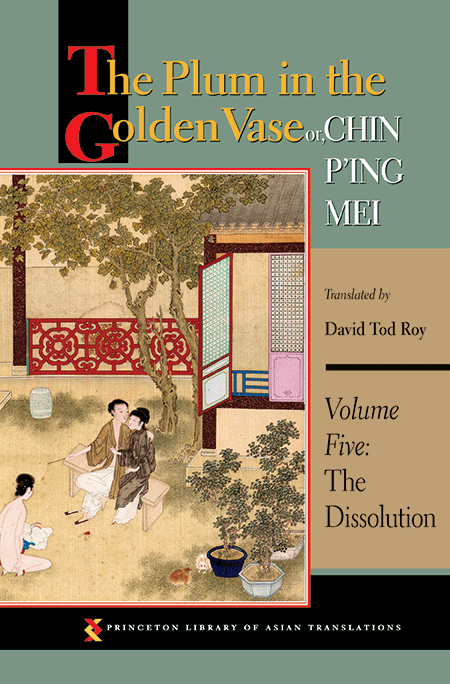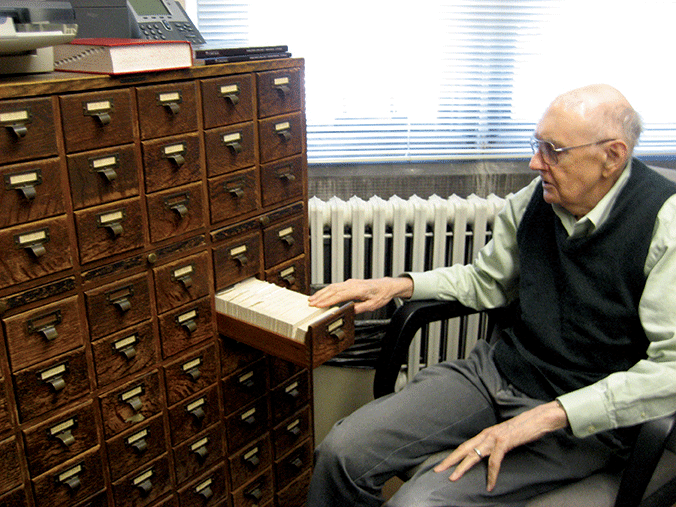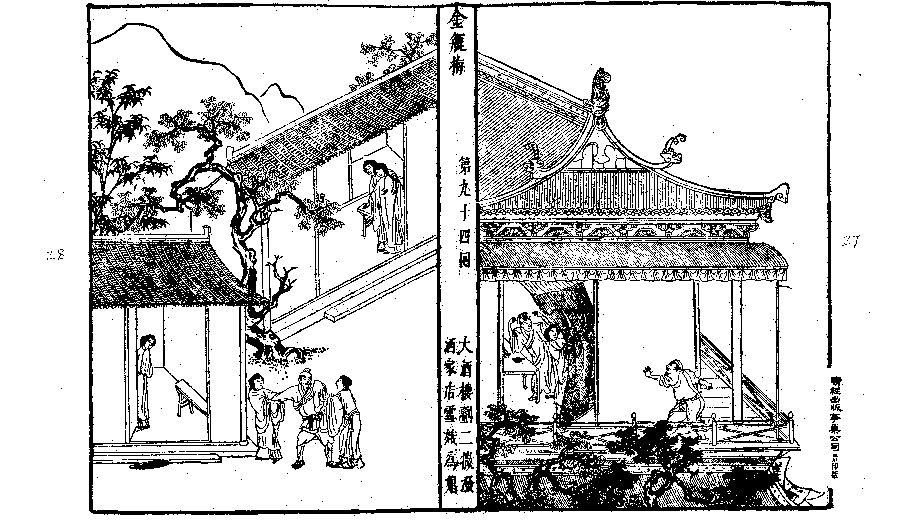Crowning nearly 50 years of scholarship, David Tod Roy, professor emeritus in East Asian Languages and Civilizations, has published the fifth and final volume of his translation of The Plum in the Golden Vase or, Chin P’ing Mei. The late sixteenth-century novel, written anonymously, is considered a masterpiece of Ming-era Chinese literature.
Since Princeton University Press released Roy’s first volume of the translation in 1993, scholars have praised his masterful translation and painstaking research. Along with extensive annotations, Roy has provided the first complete European-language version of the intricate novel, which chronicles the rise and fall of a corrupt middle-class merchant, his six wives, and his concubines.
This past spring and summer, Roy, 80, spoke about his lifelong affair with the Chin P’ing Mei in interviews and at a series of workshops with graduate students. His reflections—taken from those conversations—are excerpted here.
An adventurous childhood
David Roy: My parents went to China as Presbyterian missionaries in 1930 and spent their first two years in Beijing attending an intensive Chinese language program. My father was very good at learning languages and eventually lectured in Chinese at the University of Nanjing as a professor in the philosophy department. They moved to Nanjing in 1932 and I was born there in 1933 in the Drum Tower Hospital.
Our family returned to the United States on furlough in 1936. When the Sino-Japanese war broke out in 1937, the University of Nanjing moved to Chengdu, the capital of Sichuan province. We returned to China in 1938 and stayed in Chengdu until 1945.
I had a very adventurous childhood. In 1938–39 the Japanese bombed Chengdu, sometimes five or six times a week. Fortunately there was a very good air-raid warning system so we would spend the night in a dugout in our yard. Because of this the Canadian School, which I attended, closed down and moved to the countryside. My younger brother [J. Stapleton Roy, US Ambassador to China, 1991–95] and I were tutored by faculty members from the various universities in the city. We didn’t have any formal schooling between 1939 and 1945.
We returned to the United States while my father got his PhD at Princeton from 1945 to 1948. When we got back to China, I went to boarding school at the Shanghai American School for the 1948–49 academic year. The civil war in China was going on and every few weeks the Communist armies got closer to Nanjing and Shanghai. My parents decided that since they had gone to China as missionaries, their purpose was to communicate their faith regardless of the political situation. Instead of fleeing from the Communists, they decided to see if they could stick it out.
The Shanghai American School had about 400 students when the school year started. Every time the Communist army moved closer, a certain number of parents would withdraw their kids and send them back to the United States or wherever they came from. By May 1949, when the Communists took the city, there were only 16 of us left out of the original 400. In fact, I took my final exam in tenth-grade geometry the day the Communists marched into Shanghai.
Learning Chinese
 During 1949–50 we lived with my parents in Nanjing. There was no longer any Western school there so again, we were tutored by university professors. My father taught us poetry; I was taught physics by a professor from a local women’s college. My brother and I had fairly fluent spoken Chinese, which we simply picked up from the environment, but neither of us could read or write it.
During 1949–50 we lived with my parents in Nanjing. There was no longer any Western school there so again, we were tutored by university professors. My father taught us poetry; I was taught physics by a professor from a local women’s college. My brother and I had fairly fluent spoken Chinese, which we simply picked up from the environment, but neither of us could read or write it.My mother thought that the political situation was uncertain and we didn’t know how much longer we could stay in China. She hired a professional tutor to teach my brother and me Chinese—or reteach us—a wonderful old gentleman named Zhao Yanan. He had helped Pearl Buck translate Shui Hu Zhuan, the famous Chinese novel that had a great influence on the Chin P’ing Mei. Her translation was published under the title All Men are Brothers in the mid-1930s.
We started to relearn spoken Chinese with this tutor. After a week or two I asked him to show me how to write my name and our street address in Chinese. He wrote in large characters, numbering the strokes. I stayed up half the night writing my name and address as best I could and I asked him for more of this kind of thing. I became totally obsessed with the language; the written script of Chinese was so much more interesting than any western alphabet. I made very rapid progress and by the end of the year I could actually read a Chinese newspaper.
Discovering a classic
I developed an interest in traditional Chinese fiction since I had been interested in literature in English. I started boning up on the most famous works of traditional Chinese literature: Romance of the Three Kingdoms, Water Margin, Journey to the West, Chin P’ing Mei, and Dream of the Red Chamber.
I found out that the Chin P’ing Mei had a reputation for pornography because it contained many vivid descriptions of sexual activity—although they were no more detailed than its descriptions of eating, costumes, political corruption, funerals, and so on. The book gives by far the most detailed description of everyday life in Chinese society that had appeared before that time. But I was a teenager so I was excited by the prospect of trying to read something pornographic.
Deleted passages
There were many expurgated editions where the sexual passages had been deleted. You would sometimes read along in Chinese and then all of a sudden it would say, “the next 560 characters are deleted.” I learned that there was an English translation done by Clement Egerton in 1939. I got it from the University of Nanjing library, but to my disappointment, the sexual passages were rendered into Latin. I could make out some of them, but I decided to try reading it in Chinese. It was very difficult, but I was fascinated.
In 1950 I found an unexpurgated version of the novel in a secondhand bookstore in the Confucian Temple area of Nanjing. During the Communist era, many people got rid of books that were considered dangerous to own, so there were rich pickings to be had at bookstores.
An abiding interest
From 1950 on, I continued to be a student of the Chin P’ing Mei. As an undergraduate at Harvard I majored in history and studied languages and literature. I wanted to become a China specialist.
Midway through college, I was drafted into the Army for two years during the Korean War. I took a Chinese test and was put into the Army Security Agency. They sent me to Japan and Taiwan; I spent a year in Taiwan listening to military broadcasts and reading handwritten Chinese transcripts, so my written Chinese got very good. In 1956 I left the Army, was readmitted to Harvard, and did my graduate studies there.
From research to translation
At Harvard and later at Princeton I taught Chinese literature in translation. For my survey courses, I assigned a one-volume abridged English translation of the German translation of the Chin P’ing Mei that was done in the 1930s.
In 1967, when I came to the University of Chicago, I got to teach a seminar on anything I wanted. I chose to teach the Chin P’ing Mei in Chinese—but only one student signed up. I ran that seminar for two years, covering one chapter each week, and it further enhanced my fascination with the book. The novel is loaded with poetry and songs. Few, if any, were written by the author of the Chin P’ing Mei, but the authors of the poems were not identified. I started doing research on the sources and after a few years, decided to research the sources in detail.

I came to believe that in order to study the Chin P’ing Mei accurately, I would need to have some means of control over the text, so I spent about two years making a card index of every line of poetry, parallel prose, and proverbial sayings in the entire novel. I ended up with tens of thousands of file cards. People said, “Why didn’t you hire a graduate student to do that?” But I knew that wouldn’t have worked. With this information at my fingertips, I could read through earlier Chinese drama and poetry, and whenever I saw something that seemed familiar, I could check the index cards within seconds to see whether or not that phrase occurred in the Chin P’ing Mei. That’s how I wrote the notes of my translation. Without having compiled this index, I never could have done it.
I tried to read every extant work of Chinese fiction and drama in circulation before the Chin P’ing Mei was published. That’s a huge project, but I kept discovering more and more sources.
At the same time, my colleague Anthony Yu [the Carl Darling Buck Distinguished Service Professor in the Humanities] had undertaken his own translation of Journey to the West. I was impressed and inspired by his example to undertake a translation of the Chin P’ing Mei. Also, I had a brilliant graduate student named Katherine Carlitz [AM’74, PhD’78], now at the University of Pittsburgh, who did a dissertation on the use of Chinese drama in the Chin P’ing Mei. She also urged me to do a translation.
Plowing ahead
I started the translation in 1982 and I finished in 2012, so it took me 30 years. I mostly only had summers to work on it. Back in those days we used to teach nine classes a year at the University of Chicago. I just thought I would start and see how far I could get. A lot of my colleagues thought I wouldn’t finish, but I decided to plow ahead. In 1999 I was only 65, but I took early retirement so I could work full-time on my translation. I picked up speed after that.
Highlighting difference
Other books, prior to this one—for example, Romance of the Three Kingdoms—had been written in a uniform style. The Chin P’ing Mei is challenging because the author borrows from the entire spectrum of Chinese literature—Taoist and Buddhist ritual texts, poetry, quotations, popular songs, oral storytelling, street slang, and argot peculiar to courtesans. There’s every level of Chinese and that makes it particularly difficult to translate.
In the Egerton translation, the language is very uniform. If the Chinese sentences were complex, he rendered them into simple, plain English. With my translation, I decided I would try my best to render it to give the English reader some feeling for the rhetorical style and structural framework of the original. I indented the poetry, proverbial sayings, and parallel prose, for example, to highlight that difference rather than glossing it over.
Difficult but worthwhile
Up until World War II, most English-language translators of Chinese and Japanese novels made them try to sound as much like Western literature as they could, because they didn’t want to make the books too esoteric for readers. I decided to do the opposite, to use my translation as an opportunity to introduce Western readers to Chinese culture.
The body of the Chin P’ing Mei incorporates something like 900 passages of poetry and parallel prose description—much of this material is borrowed from earlier works. I thought it would be important to identify the sources of the quoted material wherever they were ascertainable, and that such a complex work needed to be heavily annotated if all the features of the text were to be brought out.
In Chapter 29 the fortune-teller Immortal Wu tells the fortunes of each major member of the household. That took me over two years to translate, by reading traditional Chinese fortune-telling manuals and trying to master the system.
Why it’s a masterpiece
This novel was first published around 1618 and if you look at world literature at that time, the only novels of comparable quality are The Tale of Genji (1010) and Don Quijote (1615). The Chin P’ing Mei does not resemble either of these, but it is an equally sophisticated work of prose fiction with many, many features that are unprecedented in previous Chinese and world literature.
For example, it presents an extraordinarily detailed picture of daily Chinese life at the time it was written. The rich detail makes it an invaluable work for students of Chinese society. All the preceding great works of Chinese vernacular fiction deal with life at the imperial or military commanders’ level, or in the case of Journey to the West, the mythological level. But this novel deals with ordinary, believable people who might be your next-door neighbors—although you might not like having them as neighbors. It includes characters from the top and middle of Chinese society down to servants, street hawkers, and singing girls. This is also the first Chinese novel to depict female psychology in convincing terms. There are heroines in earlier works, but they are either completely good or completely bad.
Finally, this is the first Chinese novel to have such a carefully planned, symmetrical plot and an elaborate rhetorical structure. The Chin P’ing Mei is 100 chapters in length, organized in decades. Major events take place in the seventh and ninth chapters of each decade. Earlier novels were episodic and not structured in this way. For these and other reasons I believe it is not only one of the four masterpieces of Ming fiction, but also an extraordinary, path breaking work in a Chinese and world literary context.
Once forbidden
The Chin P’ing Mei has been banned by various Chinese governments ever since it first appeared, including that of Mao Zedong. Interestingly, Mao’s diary indicated that he was an avid fan of the novel and thought it was a profound work, but he didn’t want his citizens to read it. One edition was published under Mao’s aegis, but it was restricted only to upper levels of the Communist party.
Now the book is available, but it’s not always easy to obtain. Since Mao’s death there has been a flood of scholarship in Chinese on the Chin P’ing Mei; there is even a periodical on Chin P’ing Mei studies. I’ve drawn heavily on that material, but I’ve actually discovered quite a few sources that haven’t been identified yet by Chinese scholars.
How it felt to finish, after 30 years
It felt great, mainly because I could thumb my nose at the people who said I would never finish (laughs). Unfortunately, I was diagnosed with ALS around the same time as I completed the work, so I associate my accomplishment—if I can be so bold as to call it that—with my decline.
The next frontier
One idea that’s been discussed is to bring out an edition of my translation with simplified notes. The advantage is that it might appeal to a larger audience. Specialists like the notes, but non-specialists are put off by them.
Anthony Yu has produced a condensed version of his translation of Journey to the West and some people have suggested I do the same with the Chin P’ing Mei. But I believe the novel’s greatness is best preserved in its entirety.
—Edited and condesned by Elizabeth Station with thanks to Theodore Foss, AM’74, PhD’79; Lintao Qi; and Shengyu Wang, AM’11
ILLUSTRATIONS COURTESY PRINCETON UNIVERSITY PRESS



Comments
illustrations for DTR's Chin P'ing Mei (Princeton)
What is the source? I cannot find any attribution anywhere in volume I
Re: illustrations for DTR's Chin P'ing Mei (Princeton)
The image reproduced here is from Volume 5. If you can obtain a copy of the book, I believe the source will be noted there. Here's a link to the book publisher with further information: http://press.princeton.edu/titles/10120.html
Use of Wade System is the only fault
I think that the only fault of Prof. Roy's translation is that he used Wade System of Romanization instead of the Pinyin system. Although the Pinyin system was first adopted by the commies, but it is a little better than the Wade system.
This article is very touching
This article is very touching. I do admire Prof. Roy's work. I have read a little part of the Chin P’ing Mei in Chinese. But i did not see the deep meaning of the novel.
Re: This article is very touching
If you have time to read this long posting at Tianya, you'll understand why Jin Ping Mei is so great a book. http://www.tianyatool.com/article/pub-books-1-147359/page-1.htm
David Tod Roy's Translation of Jin Ping Mei
I am currently reading Jin Ping Mei for a class at UC Berkeley. The translation is a masterpiece of scholarship and literary craftsmanship. I especially appreciate the index. All novels should be indexed, but very, very few are. That Professor Roy created an index is a sign of his devotion to the novel and to scholarship. Thank you for this wonderful book.
Thank you, Prof. David Tod Roy
A scholar's reach transcends time and creates immortality, not only for the body of work but for the person as well. Although I never had the opportunity to meet Prof. Roy when I attended the U of C, I feel that I know him and can't wait to read his translation of "Chin P'ing Mei."
My gratitude to Professor Roy
I had the privilege of attending the seminar series on Chin Ping Mei that Professor Roy gave at the University of Chicago in 2014. The scope of his scholarship and research and feel for Chinese literature and culture is unparalleled. He was born in Nanjing, my Chinese "hometown," where I taught for a year at the same university his father did--Nanjing University. I felt we had a special bond in Nanjing.